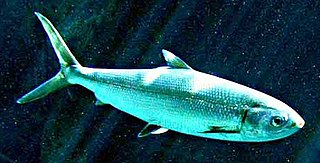
The Gonorynchiformes are an order of ray-finned fish that includes the important food source, the milkfish, and a number of lesser-known types, both marine and freshwater.
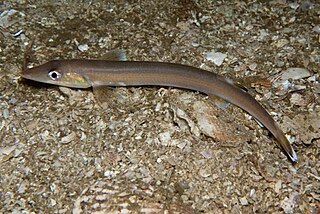
Gonorynchidae is a family of ray-finned fish in the order Gonorynchiformes, which has a number of fossil taxa and one extant genus, Gonorynchus, the beaked salmons. They are an ancient group, with fossils known from as far back as the Albian stage of the Early Cretaceous.
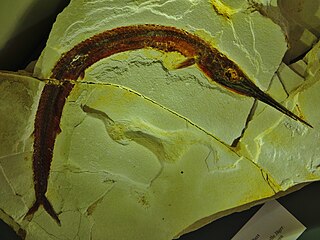
Belonostomus is a genus of prehistoric ray-finned fish that was described by Louis Agassiz in 1844. It is a member of the order Aspidorhynchiformes, a group of fish known for their distinctive elongated rostrums.
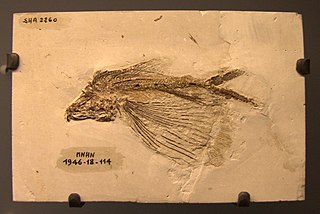
Cheirothrix is an extinct genus of marine ray-finned fish from the Late Cretaceous. It is named for its enlarged pectoral fins, which show close convergence with modern flying fish.

Dercetis is a genus of prehistoric marine ray-finned fish. It is the type genus of the family Dercetidae, a group of slender, elongate aulopiforms, which were related to modern lizardfish and grinners. It is known from the Late Cretaceous of Europe, the Middle East, and western North America.
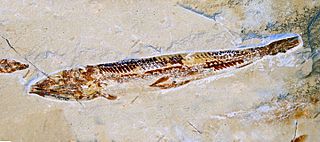
Prionolepis is a genus of prehistoric ray-finned fish belonging to the order Alepisauriformes.

Chirocentrites is an extinct genus of marine ray-finned fish in the order Ichthyodectiformes. It contains a single species, C. coroninii, from the Late Cretaceous (Cenomanian) of Slovenia. A potential specimen is also known from the Albian-aged Pietraroja Plattenkalk of southern Italy, but it has been suggested that this specimen actually represents Cladocyclus.

Coccodus is an extinct genus of marine pycnodontid fish that lived during the Late Cretaceous. The various species had a pair of massive, curved spines emanating from the lower sides of the head, and one curved spine on the top of its head. Unlike most pycnodontids, Coccodus species had a comparatively long body, giving the living animals a superficial resemblance to a scaly chimaera.
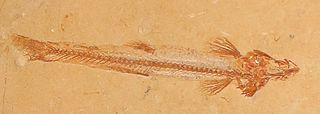
Charitopsis is an extinct genus of prehistoric marine ray-finned fish that lived during the lower Cenomanian. It was a relative of modern beaked salmons. It contains a single species, C. spinosus from the Sannine Formation of Lebanon. It is possibly related to the sympatric gonorynchid Charitosomus, although some anatomical traits are more similar to the Cenozoic gonorynchids.

Dastilbe is an extinct genus of prehistoric marine & freshwater ray-finned fish from the Early Cretaceous of Brazil. It was a relative of modern milkfish.
Ctenocephalichthys is an extinct genus of prehistoric marine ray-finned fish, generally considered a holocentriform, that lived during the Late Cretaceous. It is known from Cenomanian to the Santonian of Lebanon.
Dinopteryx is an extinct genus of prehistoric beardfish from the Late Cretaceous period. It contains a single species, D. spinosus, known from the Santonian of Lebanon. It is the only member of the extinct family Dinopterygidae, which is considered a distinct family of the Polymixiiformes. It was previously placed in the genus Hoplopteryx.
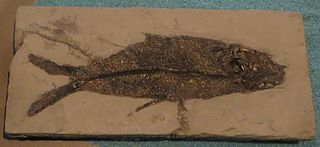
Aethalionopsis is an extinct genus of prehistoric freshwater bony fish from the Early Cretaceous of western Europe. Formerly classified as a species of the elopiform Anaethalion, it is now known to be a relative of the modern milkfish (Chanos) in order Gonorhynchiformes. It was previously placed as a basal member of the suborder Chanoidei, but is now more often placed as a basal member of the subfamily Chaninae of the family Chanidae, placing it closer to the extant Chanos.

Anaethalion is an extinct genus of prehistoric marine and freshwater ray-finned fish related to modern tarpons and ladyfish. It is known from the Late Jurassic to the Early Cretaceous of Europe and northeasterrn Asia, roughly encompassing the Tethys Ocean.

Ctenothrissa is a prehistoric genus of marine ray-finned fish in the order Ctenothrissiformes. It contains a number of species known from the Late Cretaceous of England and Lebanon.
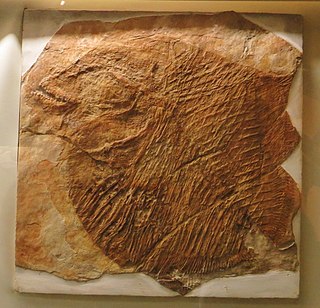
Coelodus is an extinct genus of marine and possibly freshwater pycnodont fish. It contains only one definitive species, C. saturnusHeckel, 1854, from the Late Cretaceous of Slovenia. Other species from the Late Jurassic to the Eocene have also been attributed to this genus based on isolated dental elements, but their assignment to Coelodus is uncertain, and this genus likely represents a non-monophyletic wastebasket taxon. A potential diagnostic trait is a prearticular tooth row with three regular highly elongated teeth.
Caeus is an extinct genus of prehistoric marine ray-finned fish, closely related to the modern milkfish. It contains a single species, C. leopoldi from the Early Cretaceous of the Pietraroja Plattenkalk, Italy. It is one of the largest teleosts known from the Pietraroja formation, and is known by only a single specimen.

Davichthys is an extinct genus of prehistoric marine ray-finned fish related to modern ladyfish. It is known from the Late Cretaceous of southern Europe, the Middle East, and North Africa. It is one of the earliest known elopids.

The Sannine Formation, also called the Sannine Limestone, is a Cretaceous geologic formation in Lebanon. It is a Konservat-Lagerstätte that contains a high diversity of well-preserved fish, reptiles, and invertebrates from the Tethys Ocean within its three main localities: Haqel, Hjoula, and Nammoura.

Cheirothricidae is a family of extinct marine ray-finned fish, perhaps belonging to the Aulopiformes, although they are tentatively placed as indeterminate eurypterygians. They lived during the Upper Cretaceous and their fossil remains are found in the Middle East and Europe. They were characterized by very expanded even fins.















